My dad and I have slightly differing recollections of the time he caddied for me in an amateur golf tournament. His version of events is that I royally fucked up all on my own and, not having the maturity to take the blame, loaded it straight onto him, in eviscerating dollops. “HE STOOD THERE ON THE GREEN AND GAVE ME A RIGHT BOLLOCKING,” he will still tell friends and family now, a quarter of a century after the incident took place. “I THOUGHT, ‘I’M NOT DOING THIS AGAIN, YOU BLOODY UNGRATEFUL GIT!’.” While it is true that I might have had sharp words with him after the incident, this version does not quite tell the whole story.
I’d been slightly reluctant for my dad to act as my caddy, going into The Dukeries tournament at Worksop Golf Club, in Nottinghamshire. In most of the competitions I played in, which unlike The Dukeries were solely for under-18s or under-21s, family members as caddies were strictly prohibited, and with good reason. Boys’ golf in the Midlands could already be an ugly battlefield, on which sporty parents lived a little too hard through their offspring, getting vocally overinvolved in their fortunes. The potential intensity of father-son – or, in some cases, mother-son – caddy-player relationships could only heighten this ugliness.
My dad, however, was not one of the Competitive Sporty Dads: he didn’t even play golf, and his interest in the game took the sole form of a benevolent wish that I continue to enjoy and be as marginally successful at it as I had been, not least because over the last few years it had steered me on a path away from my local town’s traditional teenage pursuits of glue-sniffing, vandalism and car /JCB theft. My one previous experience involving a family member as a caddy – my similarly non-golfy granddad – had led to a flagstick being put in my golf bag by mistake, which made me wary. I knew that I would not get the same level of diligence from my dad that I had made a point of pride during my own caddying days: there would be no judgement of wind strength, no club advice, no help lining up my putts, no between-shot cleaning of the grooves on my clubheads. But I was tired after a summer of hauling a bag of heavy iron around on my back, and having a caddy would enable me to strut down the fairway in a manner that I hoped was loose and swashbuckling, further preserving the temporary delusion that I was Seve Ballesteros.
Everything was going sort of okay between us until the par 5 tenth when, after putting my tee shot in trouble and hacking back onto the fairway out of the rough, I hit an errant third shot into a greenside bunker, and, after striding purposefully towards it, mentally reprimanding myself with every step, found my ball wedged up against the back lip of the sandtrap, a tussock of sand-salted grass sitting awkwardly behind it. I turned to my dad to ask for my sand-iron, but he was not anywhere in evidence. I peered back up the fairway but there was no sign of my dad, nor the beloved bag of golfing weaponry that I had left in his care. The fairway was very tightly mown and it seemed impossible that an average-size man in his early 40s could just disappear into such well-clipped turf. Had he fallen through a rupture in time and space? By this point my playing partners, who had both played safely onto the green with their approach shots, had marked their balls and were looking at me quizzically. Worksop was a tough course, known for producing fine, tenacious players, such as the future Ryder Cup star Lee Westwood, few of whom suffered fools gladly. Lost balls in Worksop’s gorse and high rough were common, but lost dads were less common and there was no bylaw in the club’s rules referencing what to do when you had one.
The official amount of time a player is permitted to search for a ball during a golf tournament before it must be declared lost was and still is five minutes. I took just under five minutes to find my dad, but it felt like at least a dozen times that long. Would I have declared him lost if it had taken longer? Perhaps. I would certainly have thought little of disowning him. By that point, here in the crucible of top class amateur East Midlands golf, the group of players behind us were waiting on the fairway to play their approach shots, gesturing impatiently. In the group behind them, some five hundred yards distant, on the tee by now, also waiting, would be Westwood himself. I found my dad, totally oblivious to this high pressure situation, about thirty yards off the fairway, hidden by some heather and a stand of willows, looking up at the sky through his binoculars.
“Bloody hell, what are you doing?” I asked
“BUZZARD,” he said. “THOUGHT I SAW IT EARLIER, AND I DID.”
“I need to play my shot, and you’ve got my clubs.”
“I THOUGHT YOU’D BE OK WITH THE ONE YOU’VE GOT IN YOUR HAND.”
“It’s a three wood. You can’t play a greenside bunker shot with a three-wood. Any idiot knows that.”
“OH, SORRY.”
I firmly grabbed the throat of my sand-iron, as you might grab the throat of a diseased hen whose euthanasia you’d been postponing for too long, and stormed back to the bunker, where I proceeded to record a very harassed quadruple bogey eight in front of my bemused and increasingly impatient fellow competitors. I did not feature on the leaderboard of the tournament, and my dad and I spoke very little for the remainder of the round. By the thirteenth hole, I was once again sole custodian of my golf bag. My dad, who had got hint of a lesser spotted woodpecker, was over in some pines near the sixteenth tee.
I began to properly glean the sacrifices my dad made to support my teenage golf obsession from the moment I gave up my ambition to be a world class golfer – about a year after the buzzard incident – but I think I see them even more clearly now. In driving me to tournaments around the middle and north of the country for four successive summers at the end of my childhood, his was not just a sacrifice of hours and petrol money, as I realised at the time, but a sacrifice – arguably far bigger – of environment. Here was a lifelong lover of rusticity and nature, thrust haphazardly into the most ersatz of bucolic habitats, week after week: forced to walk over pesticide-laced hillocks, across naff ornamental bridges and down overneat Daily Express sapling corridors, making chit-chat with people from another universe. My dad was an atheist stranded in the Church Of Golf, which was a church that did have the bonus of being green but always seemed to have the contrast up a bit too high, like American TV news of the same period. How could you not cut the guy a bit of slack and allow him to wander off into the undergrowth edging this overmanicured land and attempt to wring some naturalistic enjoyment from it as a respite from the hours of stilted pleasantries, restricted footways, mindnumbing sports casual banter and arcane etiquette?
I’ve sung my lungs out in the choir in the Church Of Golf, right up near the pulpit, so I totally get how it works. You arrive at the conclusion that golf is all-important, all-conquering and all-usurping, to the extent that you believe you need nothing else that the outside world has to offer. Why would you, when golf is a microcosm of life anyway, with similar tests of patience and spirit, similar trials and disappointments? “To find a man’s true character, play golf with him,” PG Wodehouse wrote: a quote which, though it might well be true, also underlines the view of the true golfer that golf is the Real World and all the stuff outside its car park security gates is just so much flim-flam. Throughout 2006, I played golf professionally, to a very poor standard, on a lowly tour crowded with swinging nearly-greats, and I saw that this tunnel vision worship of golf was mandatory for success. The pros who had it were the ones who made a living out of the game; the ones who didn’t, didn’t.
So it logically follows that someone fully inside the Church Of Golf and fully committed to it – even, perhaps, someone who was generally enthusiastic about the countryside – would not stop to think critically about golf’s relationship with nature, because anything golf does to the detriment of nature would be in the service of Golf, which is the one true God. I’d been very outdoorsy for the first decade of my life and grew up in the countryside so when, around my thirteenth birthday, golf got me in a lasting headlock where indoor sports I’d arguably shown a little more natural aptitude for – badminton, snooker – hadn’t quite managed to, I’m sure that headlock must have been something a lot to do with my childhood predilection towards trees, natural turf and flora, whether I knew it or not. But once in the headlock, I didn’t show any actual tenderness towards the trees or flora; to me they were like obstacles on a computer game I was playing. As for the turf, I was highly critical of it at any point that it misbehaved and tried to do its own thing in a way that would be potentially detrimental to my score. If in my rare non-golfing moments I went past a patch of colourful countryside I was instantly sizing it up, mentally cutting a soulless topdressed tunnel through some pines to make a fairway, wondering what a grassy hollow was doing wasting away without clean neatly-raked white sand in it, or using my brain to bulldoze a space for a green behind the bullrushes of a healthy wildlife pond.
These days I could not have a more polar attitude to that one. I see a golf course and I am instantly willing nature on, urging Japanese knotweed to go crazy and swamp flagsticks and teemarkers, delighting in a utopian-disguised-as-dystopian future of ivy bringing down the sport’s many unimaginative clubhouses, strangling their twatty mock turrets and, if possible, the even more unimaginative mock classic houses that tend to back on to its more hallowed fairways. My naturalist blasphemy in The Church Of Golf was in effect as early as twelve years ago, at the last club where I had full membership: Thetford, in Norfolk. I’d come back to the game after a lay off of many years and was playing it well – perhaps, on a purely aesthetic level, better than I’d ever played it before – and was already thinking forward to my pro adventure: a year on the tour, to answer the lingering unanswered question of my twenties, “Would I have been good enough to make a living at this game, if I’d persevered?” But there was something missing. In short: I was not nearly angry and frustrated enough at the bad shots and unlucky breaks that occurred during my competitive rounds. A good example of this was when the perfectly straight and solid tee shot I hit on the par four seventh in a weekend tournament at Thetford nestled in a rut made by a badger, causing me to rack up a round-destroying triple bogey.
“That was some seriously rotten luck you had back there,” my playing partner said, as we walked to the next tee.
“I know – a real bastard,” I said, trying my hardest to appear upset. “But what can you do?”
Each year, Thetford sent out their annual newsletter and the minutes of the club’s AGM to all their members. In the latest, several pages had been devoted to what was widely being referred to as ‘The Badger Problem’. For some months, it had been the big talking point around the club bar. Roger, a man who’d asked to join me for a few holes late one weekday evening, “before I pop off to meet my nephew and shoot some rabbits”, put forward the opinion that the badgers should be culled and made to pay for the criminal damage they were doing to the seventh fairway. Recently, the greenstaff had installed an electric fence, but this hadn’t deterred the badgers, and the right side of the fairway had become even more pockmarked with their endeavours. I found myself rooting hard for the badgers, even when they messed up my score. Part of me would have even liked to have snuck up to the course at dusk and coaxed the badgers onto the short grass with a bag of dry roasted peanuts. If I was honest, this was probably significantly bigger than the part of me that wanted to take the pro game by storm the following year, earning thousands of pounds a week and becoming renowned for my flamboyant style of play, huge teeshots and eclectic headwear. This badger-whipped part of me is now far more out in the open and would, along with my tendency to tell the most rigorous version of the truth when confronted by authority figures, no doubt prove to be my downfall in the hugely unlikely event that I was ever to become a member of a golf club again.
Club Captain: “We have had reports from persons who wish to remain anonymous that you’ve been feeding badgers peanut butter sandwiches in the sectioned off Ground Under Repair area just to the right of the eighteenth tee, next to the Ken Holloway Memorial Bench.”
Club Vice Captain: “Now, we don’t want to jump to any conclusions before we’ve heard all sides of the story, and we realise the whole thing might just be a misunderstanding, so we’d like to hear what you have to say about it, before we take any disciplinary action.”
Me: “No, it’s totally true. You heard correctly. I’ve been doing it twice a week for the entire summer, at dusk. Except I’ve changed to smooth now. I was going with crunchy, but I noticed that it seemed to stick to their gums a bit, and I worried that they found it uncomfortable.”
This, then, is the traditional profile of the golfer: he is The Enemy Of The Badger, The Scourge Of The Wildflower Meadow, The Wanker In The Former Orchard. If he is found in a garden centre, it will be in one of those vast superstore-like ones, and he will be in its weedkiller aisle, cackling. A golf course is marginally easier on the eye than your average new housing estate but its construction is certainly not as justifiable. It’s a self-indulgent, overlong sport, not happy sticking to the hour or ninety minutes that normal sensible sports take to play, insistent on swallowing the entire day of anyone who plays it. And in keeping with its rigorously overlong, self-indulgent nature, its courses have to be self-indulgent and overlong too: carved out of what could be verdant forests or birdy heathlands, snaking on for sodding ever, solely in the service of golf, the ultimate game of the biodiversity-indifferent intellectually incurious, and getting even longer, as they keep up with the game’s equally unnecessarily yardage-crazed technology. And the blight goes beyond the course itself, because with every high end golf course come houses for people who want to play on the high end golf course, and those houses are inevitably overlarge and indulgent too, and very rarely attractive. How can I justify carrying on hitting balls and colluding with this marauding blight on the British countryside, at a time where space has never been more in crisis, in what is now officially one of the world’s most nature-depleted countries?
Yet – sue me – I still like golf: this slightly unsporty sport that I still, preposterously, retain professional status at. I don’t like its relationship with the environment, I don’t like its clothes, I don’t like its reserved parking spaces, I don’t like its politics and I don’t like its petty social hierarchies, but if we are speaking purely about the sensation of metal connecting with spherical rubber at high speed… yes, I like that. Love it, in fact. In that sensation, there seems to me something deeply spiritual and predestined. It feels, at its purest, like something that humans were meant to do, even if the larger act that has historically gone hand in hand with it – moulding former wildlife havens into an overgroomed fake rusticity – does not. I would not recommend playing bad golf to anyone interested in the notion of mindfulness – it’s a wretched business that leaves you with one foot in an anxious future and the other in a broken past, with nothing in the space between actually planted in the present, with the possible exception of some frightened genitals – but I can think of few more meditative acts than hitting a golf ball well. The impact takes a fraction of a second, yet it seems to linger, as if clubhead is superglued pleasurably to ball. Some of the most peaceful moments of my life were spent doing exactly this in the hour or two before dusk at Thetford – a place where you don’t have to stray far from the fairway to be deep amongst the largest lowland pine forest in Britain, as wild an area as you will find in non-coastal East Anglia – to no sound but the coo of wood pigeons, the distant bark of muntjac deer and the skitter of rabbits through the heather and underbrush. Still, even now, if I’m walking on heathland, and the grass underfoot gets tight and spongy I might take a moment to visualise a crisply dispatched iron shot from it, the spin that the special interface of situation and strike might impart on the ball, the way the purity of it would feed back into my wrists and arms and cerebral cortex. But I take a deep breath and the feeling passes before it gets hold and causes any serious jeopardy to me as a person.
On a calm morning back in March this year in the special rinsed orange-pink light you get after a violent twenty four storm, you could have looked out onto the course at Thorpeness in Suffolk at dawn and had some serious golfing loner fantasies. From your hotel window you might have pondered the third tee, sandwiched between pro shop and clubhouse, and visualised your drive flying over the brow of the hill, right of centre of the fairway, and gently taking the camber, to leave an inviting short-iron approach shot to the green from beside the town meare, with its Peter Pan-themed islands. You could burn this place up, you might have thought, unimpeded, unpressured, before any of your fellow players were up and out, and still be back in time for a hard-boiled egg. But you’d be wrong. This modestly sized course brought me to my knees the last time I played it. I lost so many balls in the gorse on the edge of its fairways that I only managed to complete my round thanks to some unidentified missile that I found while looking for the final remaining one I’d brought with me. Were it not for a solid core that did not look like it would be easy on the teeth, I could have easily mistaken it for a root vegetable. I believe it was a golf ball but I cannot be entirely certain. I assume its half-submerged position when I found it might have been something to do with the tank practice that the course’s rough was used for during the Second World War.
Many would have seen today as a time to even the score with Thorpeness and come out with all guns blazing, but I’m not an all guns blazing kind of golfer. I only have two guns, at the very most, and they’re not actually guns; they’re joss sticks. I looked out at the third tee with the ingrained anxiety that comes from years of looking out at golf courses after a night of deficient sleep, gauging the weather, and picturing all the stuff that could go wrong, then was struck with the liberating recollection that I wasn’t going to play the course this morning; I was just going to walk it with Thorpeness greenkeeper Ian Willett, who was going to show me all the great stuff he was doing for nature on its margins. “Ooh, it looks chilly out there. If I don’t connect with my first iron shot I’m going to get one of those horrid sensations you get on a cold morning when you don’t connect with an iron shot, aren’t I, when it feels like you have grabbed hold of an electric fence with both hands, but also that the electric fence is made of ice? HOLD ON. I’m not going to hit any iron shots. I’m going to look at owl boxes. BRILLIANT!”
Ian had been having one slight problem with his owl boxes of late: some of the grey squirrels in the locality, who could be invariably profiled as bad motherfuckers, had been monopolising them. “I literally stood there the other week with my ladder while one of them sat on the top of a box and pelted me with pine cones,” Ian told me, as we approached a box in the woods to the left of the eighth fairway. Largely, though, the owl boxes were doing well: recently Thorpeness had been host to short-eared owls, little owls, tawnies, even a few barn owls. A few feet to the left of this owl box was the largest pile of compost I have ever seen on a golf course: not just a compost mountain but a veritable compost skyline. Ian has been called a maverick, as a greenkeeper, but what he is doing merely seems logical: making the vast parts of golf courses where no golf is played, and the other parts where no golf should be played, into havens for wildlife. Willett still uses pesticides, but to an absolute minimum: just on the greens, and their run-up areas. In other words he’s not doing anything to impede golfers from enjoying their game, yet he’s also doing large amounts to encourage woodlark, nightjars, owls, and the 169 types of fungi common to the area.
There is something slightly comic about the fact that a rewilding project like this should happen in Thorpeness: a place overlooked by a nuclear power station, and whose signature is a kind of otherworldly orderliness. Built as a unique, uniform kind of holiday resort by the Scottish railway millionaire Glencairn Stuart Ogilvie in the early 1900s, this small village halfway along Suffolk’s coastline looks on first impression a little like it has been made of cardboard, but quality cardboard, as you might find in a high class stationers which prides itself on aesthetics. Its almshouses, Jacobean-style cottages and clapperboard nods to arts and crafts conjure up a fairy tale English quaintness that usually only exists in the mind of Americans. As I walked the village at dusk, people in windows seemed to be living undistracted domestic lives that books and films tell us we live. I passed a hibernation area for adders and returned to my room via the House In The Clouds: a seventy foot high water tower that Ogilvie converted into holiday accomodation. In 1943, a bombshell passed through the water tank at the top of the tower, while two ladies, the Humphreys sisters, were asleep in the accommodation below. Apparently, during this event, “neither lady woke up.” The tower helps with the line when you tee off at the eighteenth, and is another example of how well the course, accidentally or not, assimilates into its environment. Another is the giant golf ball dome of Sizewell’s power station that rises up on the horizon beyond the gorse in the early stages of the back nine: a vision that, during that disastrous ball-losing round of mine a few years ago, seemed to mock my ill fortunes.
Fake “classic” English styles of architecture are so often a signifier of all the other stuff that’s often so wrong on the edge of golf courses, but Thorpeness is a rare instance where they work – especially mingled as they are with mid century modernism and minor California ranch tributes. When you drive past the village meare to the clubhouse you get a sense that you are entering a more endearing kind of Little England: a bit more egalitarian and scruffy around the edges. I felt it back in 1989, when I first came here, as a teenage golf nut on holiday with my parents. My mum and dad had dropped me at other golf courses that summer and I’d been instantly sniffed out as an impostor: told I couldn’t play, due to my age or my clothes or another reason that happened to be convenient at the time. But at Thorpeness, I was instantly welcome, and spent a halcyon three days there, unself-conscious of my old clubs and factory second trousers and jumper. It’s still the same: it feels clubby without feeling exclusive and segregated. You sense the encouragement of nature is part of this. Public footpaths are threaded across the course into the scruffy acid heathland surrounding it. “We are all equals here: deer, golfers, tench, ramblers, twitchers, owls,” Thorpeness seems to say. Ian has even looked into the ecological benefits of introducing wild boar. It is not hard to picture it happening, here.
“Oh, you played at the place with the boar. How was it? Did you see any?”
“Yes! Five! They all came out as a family to watch me tee off over the wild pond on the par three seventh. My shot just made it over the water, by about three inches. They gave me a collective withering look then returned to the trees.”
The day after my visit to Thorpeness, I drove twenty five miles down to Felixstowe Ferry to meet Michael Thomas, an ecologist who has been doing work there not dissimilar to Ian’s. Felixstowe’s Martello course is the fifth oldest in England and was the inspiration for the holes played by the tormented academic in the legendary MR James story Whistle & I’ll Come To You. It strikes me as a place synonymous with torment: golfing, meteorological and, very frequently, both combined. The grass on its fairways is tight but as soon as you leave it you’re in thick rushes and reeds, well-filled ditches and streams: increasingly wild habitats for water voles, kingfishers, little egrets, terns and grey herons. Thomas showed me two owl boxes installed last year where kestrel and barn owl chicks have respectively hatched. This is a very different environment to Thorpeness: it’s a bare, windlashed outpost, constantly at the mercy of the sea. It feels, even more than most parts of the English coast, somewhere you might come to drop off the edge of the world.
“The old ladies course is out there,” Thomas said, pointing out into the grey-brown North Sea. He meant that it was a course that was now old, and drowned, not that it was a course for old ladies. A further hole, on the main course, was lost to the waves in 1963: a par three jutting out east from the club’s signature Martello Tower, which once served as what was undoubtedly the most architecturally shit hot clubhouse in Britain, until Felixstowe’s membership outgrew it. The crustoce lichen stains on the tower walls could be the masterpiece of a restrained East Anglian Pollock. At the wall’s base, sea holly grows, considerably prettifying the course’s semi-rough. I stopped to photograph the patterns of the lichen. As I did, I heard a golfer asking his playing partner what on earth I was doing and why, and heard his playing partner respond with equal bewilderment. It’s true: Why would you photograph a composite organism arising from algae and living in a symbiotic relationship among filaments of fungus? But why would you hit a small ball around a long thin field? Why would any person do anything?
“Another great find!” announced an A4 sheet pinned to the notice board in Felixstowe’s clubhouse. “18.8.15 The greenstaff found a huge green caterpillar on the Martello 10th green. It was for the CONVOLVULUS HAWK MOTH.” Below was a photograph of the gigantic caterpillar in question, resting on a towel, looking pretty pleased with itself, as you no doubt would too if you were that big and green and beautifully patterned. I’d had to knock the ball round in two under par to win the 1990 Jubilee Bowl to get that kind of space devoted to me on the wall at my old club. This caterpillar just had to be a caterpillar. Upstairs in Felixstowe’s clubhouse an extensive archive of early photos of the membership commemorated a time when all golfers looked like stern doctors or posh homeless druids. This was the era before people realised it was easier to play when not wearing a tight-fitting jacket: a revelation akin to the fictional one where footballers realised it was easier to take free kicks while not padlocked in an old rusty gibbet. One memorable character recurred: sternly moustachioed, in keeping with the fashion of the day, but dressed in stripes, as opposed to the sombre greys and browns of his peers. A pipe smoker who draped his arms around one of his fellow competitors in an affectionate fashion that stood out in this gathering of apparently emotionally buttoned up men, he interested me. I decided his name was Bunny and that the nascent club lounge fed on stories of his escapades: the time he bet Old Jack Welch double or nothing he could birdie the last four holes and went right ahead and did it, the night of the storm when he climbed onto the roof of the Martello tower and raged, alone, at the Sea Gods. He vanished one dark autumn evening in 1897, never to be heard from again, when raindrops hit the Deben estuary like falling crab apples. Yes, there were sordid rumours, none of them ever substantiated, but this was a respectable club, didn’t you know, and you just can’t have those sort of stories floating around. By jove the scratch team missed him, though. Never known anyone who could keep a mashie under the wind quite like it.
It would be misguided to think that Britain’s first establishment golfers – businessmen, politicians, corporate movers – were men with any unique and abiding respect for the land, but the early golf courses, such as Felixstowe, were not marauding assaults on the countryside. In the 1800s Bunny and his ilk inaugurated golf courses not dissimilarly to the way children inaugurate unofficial play areas or bike tracks or football fields. They saw an unoccupied bit of countryside that suggested itself as a place where a golf ball might be pleasurably coaxed and cajoled, and they coaxed and cajoled golf balls on it. The finetuning – or land rape, as it’s sometimes alternatively known – came later. And it is true: some bits of countryside do naturally suggest themselves as golfing amphitheatres. Not the countryside I looked at with my greedy, pious golfing eyes as a teenager and mentally refurbished, but others. I first stumbled on Wrangaton golf course, on the southern edge of Dartmoor, last winter, when I was walking on the top of Ugborough Beacon inside a thick unrelenting cloud. Before I saw an actual fairway, I saw strips of land that looked like fairways: tight spongy green paths through the heather, shaped by biodiversity and weather, not by man. “Here,” nature seemed to be saying. “Hit some balls along this. But don’t go interfering too much, or putting any of your tacky little ornamental tee markers in.”
Wrangaton is a course of two very distinct halves: there’s the front nine holes, which are played at a tilt, on the side of the beacon, on lightly tended fairways, amidst sheep and cows and rocks, with ‘This Way To The Next Hole’ signs that look like ancient Pagan burial sites. Then there’s the back nine, less undulating, more manicured, hidden away behind a line of trees, out of sight of the moor, perhaps out of fear of its scowling disapproval. I enjoyed playing both a couple of months ago but it was the front nine which stood out, the front nine which seemed like a different, more ecologically encompassing vision of golf. I was joined for the occasion by my friend Seventies Pat. Wanting to ensure we were allowed to go freely on our way, Pat had dressed down for the occasion. That is to say, he had made the special concession of leaving his cowboy boots and cravat at home, but was still clad in the attire of a 1970s Playboy TV Detective who’d scored big at the poker table the previous night. It is a rare golf course where Pat’s appearance will not attract disapproving or sarcastic comments and Wrangaton is clearly a rare golf course. Rain fell from a clear bright sky as we approached the first hole: a phenomenon that is inexplicably known as “monkey’s birthday” and, upon experiencing, I always make a point of saying “monkey’s birthday” to anyone around, as I enjoy creating an atmosphere of confusion. I had half-hoped for a wilder day, maybe a large black Newfoundland dog’s birthday, at the very least, to get the true measure of this most exposed sort of British golf. A sheep and her offspring finished their business and moved aside to let us prepare for our shots. “Hey!” said Pat. “No suckling on the tee!”
Again, there was that sense that nature was not just making this a better place, but a more pleasant place to play golf. If you’ve got a sheep drinking from part of another sheep on your first par four it tends to foster an environment where people are less keen to enforce petty club rules. Again, too, Wrangaton is a club that welcomes the walker. So often the snootiest golf clubs are the ones with no public rights of way, where the area beyond the fairway looks overtreated and lifeless, like a dickhead’s garden. I was relaxed here and began to play well. So did Pat, although on the seventh he fell victim to a local hazard, his tee shot ricocheting from its landing point in the middle of the fairway, sixty yards to the right, after making contact with some jagged unseen feldspar. Or was it some quartz? I’m not sure. The point is: the ball bounced violently up in the air and off to the right, like it had hit a giant snail’s back.
Pat remained sanguine about his misfortune and stuff seemed to even up on the short par four ninth, when we walked down to the edge of the green and found no sign of my perfectly solid, straight drive. We searched for a few minutes amidst tussocks and gorse. “Don’t worry, I’ll leave it,” I announced to Pat, about to forfeit the hole, and, as I did so, a jersey cow, perhaps finally feeling bad about my plight, sat up, revealing my ball, nestled down slightly in the semi-rough, exactly where its enormous cow bottom had been. I thought about that PG Wodehouse quote about golf bringing out a man’s true character. Was that really accurate? And, if so, did I need to face up to the fact that my true character was “not that bothered about stuff, and happy to let the other guy win, if it meant an easy life”? Or maybe Wodehouse had got it wrong. Perhaps the actual case was that golf brought out a cow’s true character: truculent, lazy, but ultimately merciful.
I liked the way Wrangaton seemed to have suggested itself out of a natural landscape: the antithesis it provided to the idea of golf-course-nuked-into-existence-by-demagogue-billionaire. But I also liked the way that a landscape could turn against a golf course and decide on a whim that it was having the golfing area back to use for its own purposes. Since visiting Felixstowe I’d thought a lot about those holes lost to the sea, ghost scenes of birdies and bogies and dubiously replaced balls and pocket change jingled unsportingly on backswings, gone forever under the shifting shingle. I read with interest about Royal Cornwall: a course once esteemed enough to have been granted the patronage of The Prince Of Wales but which had vanished at some point – nobody seems to know exactly which point – during the 1950s. At the end of August, I drove the ninety minutes from my house to the south western edge of Bodmin Moor to look for Royal Cornwall. I walked eight miles in total looking for it, but could not find it anywhere. The only signs it had ever been there were a bungalow named ‘The Royal Links’ and an area that looked like it could have been somewhere you might once have teed off from, but the latter was hardly significant. In the right light, with enough imagination and alcohol, the terrace at my local pub looks like it could have been somewhere you might once have teed off from. There was a slight sense that at some point in the 1950s the whole of Royal Cornwall had been tied to the back of a truck and driven into a large quarry. There was a quarry nearby, actually. I did have a quick look but it wasn’t in there.
This is an untamed and little-populated part of Cornwall, but not in the more blatantly untamed and little-populated way you get a few miles to the east, when you’re properly on the moor. I passed not a single fellow human during my walk. In the woods near the village of Helland, a couple of the footpaths petered out into nothing. I couldn’t tell if my two year-old OS map had become out of date, or the paths just hadn’t been walked enough of late. One yellow Cornwall Council footpath sign was comical, pointing me into an angry thorn tangle that even the nimblest blackbird wouldn’t be able to negotiate a way through. After a downpour the woods felt a little tropical, in a way that Devonshire woods never quite do, however much they drip in the rain and sun. I fought my way through rampant bramble and hart’s tongue to what used to be a bridge across a tributary, tripped, fell in, finally made my way back to a path: a person’s path, with footprints and signs and everything. You tell yourself that a lot of the places you walk are “wild” but you don’t perceive the amount of human maintenance that’s being done every year to make them accessible. When nature does get a chance to move in, it does so rapidly and furiously. If it could do this to rugged paths, it’s not surprising that it can swiftly obliterate something as namby pamby as a golf course.
I wanted a more tangible example of nature kicking the crap out of golf, though: something a little more recent. I found a likely candidate in Lostwithiel Golf Club, half an hour south of the former site of Royal Cornwall, not far from St Austell. Lostwithiel had closed fairly recently: at the end of 2014. A year and a half wasn’t long but would certainly have been long enough for nature to start doing its dance across the fairways and greens. I found no information about a new owner or a new use for its space so, the week after I’d visited Royal Cornwall, I drove to Lostwithiel, following brown tourist signs that still announced the course as a functioning hotel and country club. After an aborted attempt to cross the River Fowey at one of its more shallow points, I found a gate at the back end of the course, which I hopped, and headed towards the tee of a downhill par three, feeling the illicit thrill only felt by people who believe that they could at any moment be gunned down in cold blood by a carefully concealed stranger.
The fairways of Lostwithiel had clearly been mown a few times since its demise, but they were beginning to lose their shape. The greens had become brown and pleasantly diseased, well on their way to being mere everyday grass. Himalayan balsam and blackberries edged into the first cut of semi-rough. The concrete of a path down from tee to green of the par three had become weed-tufted and thistle-ragged. There’s a special beauty to man made structures being attacked by undergrowth. You can see it in the mossed bottom of an abandoned swimming pool not far from my house, you can see it in the toppled gravestones and bramble attacks of the enormous, wild Arnos Vale Cemetery in Bristol, and you could see the beginnings of it here. It created its own special atmosphere and emptiness that was eerie in a way nothing else ever quite is. There was only the beginnings of that atmosphere here, but it was exciting to imagine what might happen next. Over the river, Lostwithiel boasted its own overgrown wild cemetery. It seemed to be beckoning to the ex-golf course, still rescueable, to join it on the Dark Side.
Being here felt deliciously wrong: somehow even more so for the fact that I’d not brought clubs. I turned onto a former par four, uphill, and disturbed a heron. It soared above the former fairway and I wondered when it had last seen a human here. Days? Weeks? Months? When I first fell in love with hitting golf balls, but was not permitted to play on a proper course, I would walk courses, mentally plotting out my shots, playing air three-wood and air six-iron as other teenagers played air guitar. If I was dragged on a walk with my parents, I always had that invisible club with me, ready for any eventuality. I held it again now and looked up the fairway. I was thinking of a particular shot Tiger Woods hit in the 2000 US Open: a seven-iron, struck with astonishing force over the brow of the hill to an unseen green, 205 yards away, way back at that time when Woods still swung with freedom and seemed to actually enjoy playing golf. I couldn’t see my green either but I instinctively knew it was a similar distance away, over the hill. My imaginary crowd seemed to hush with even more reverence than usual as I hovered over the ball. But just as I began my backswing, I hesitated. I looked back at the now heronless lake, a little sadly. I turned to my imaginary caddy and handed the club back to him. He’d given me the wrong one anyway, but that wasn’t the point. Whatever I was using, I’d have probably messed it up. It was a nice day for a walk, and what was the point of spoiling it by adding unnecessary stress to proceedings?
Take out a voluntary subscription to this site.
Read my latest book.
Read my latest golf book.
Read my first golf book.

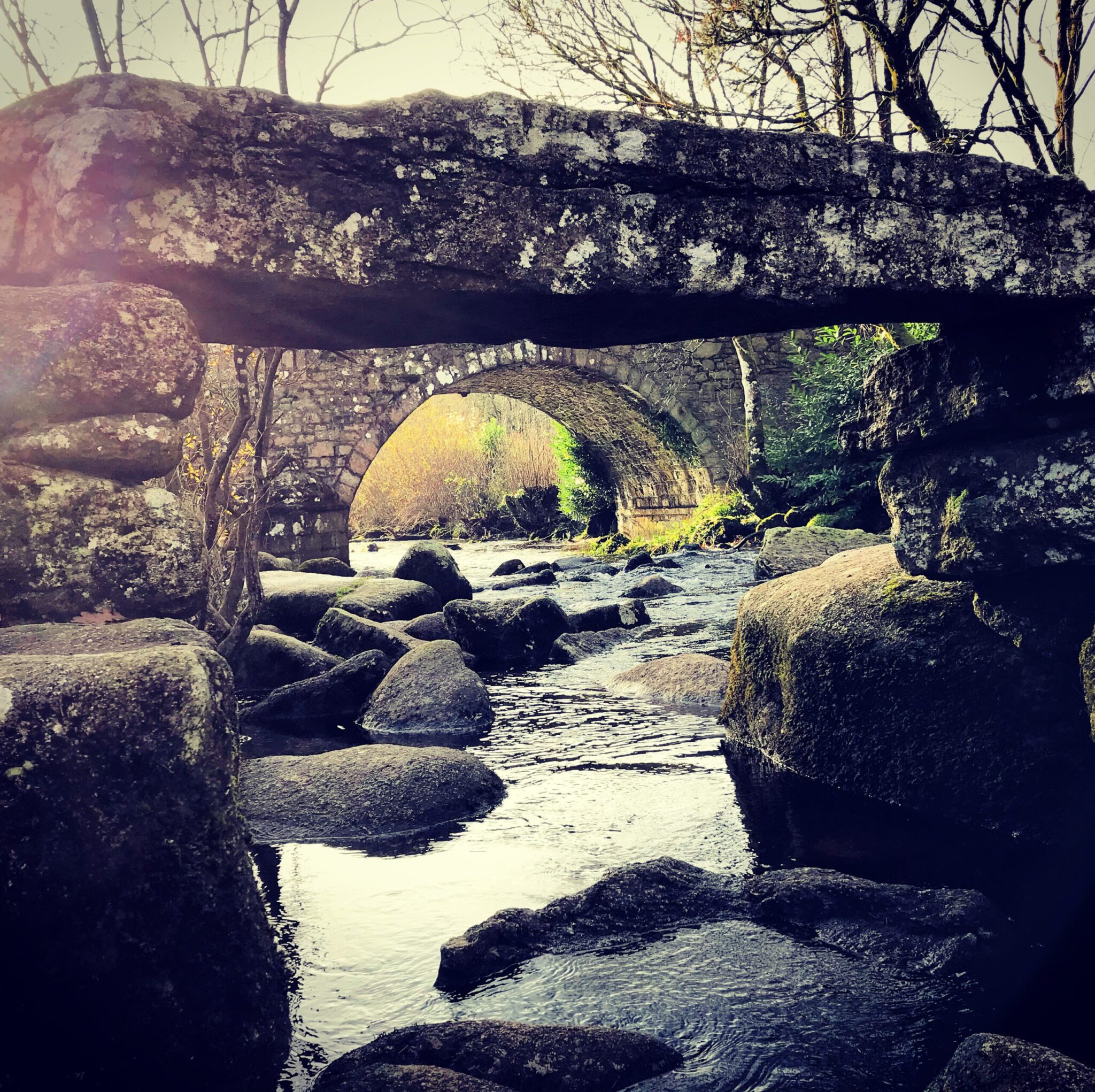
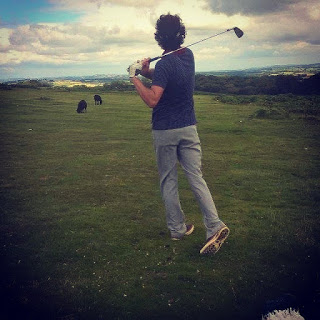
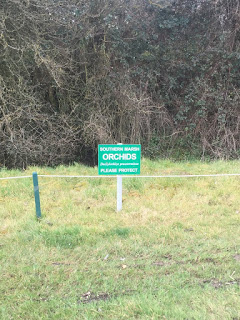
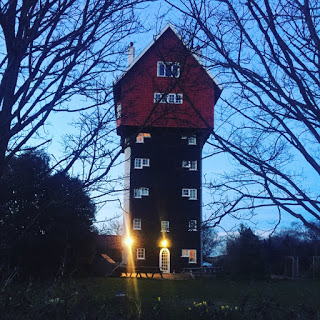
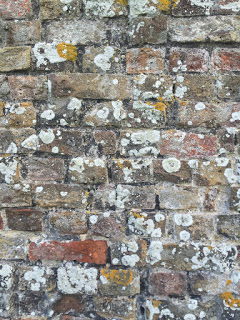
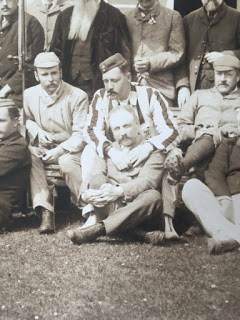
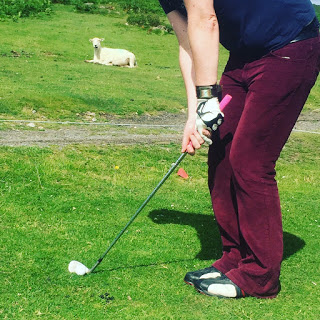
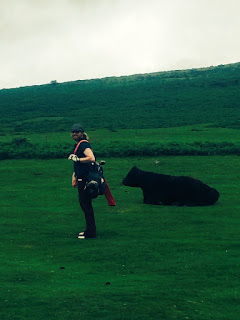
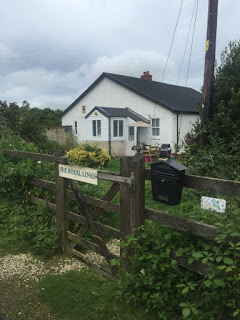
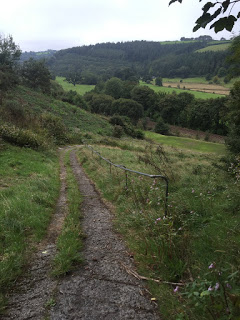
Loved it. The humour, the visuals. And…of course…the heron. Thanks for a most enjoyable read.
Tori from Ohio
Hello Tom
This writing was worth the wait.
I loved the parts about non posh golf courses and those that are being retaken by nature. Our local golf course on the western edge of Dartmoor is pleasantly rustic. Watching the golfers, I always feel they are tussling with some distracting interlopers. The ponies are tolerated as there is no real way of keeping them off the greens, and I am never shouted at if I drift onto the fairways when taking a short cut during one of my longer cross country runs.
Pleased to see Sevenies Pat's velvet trousers. He is rather a favourite of mine.
Wonderful piece! We stayed in Aldeburgh last week and walked to Thorpeness several times – amazing place! We went to that part of Suffolk 2 years ago and just had to go back despite a far from easy drive from Bristol! Love The House in the Clouds and just sitting by The Meare. Drove up by the golf club! They say Ogilvie was friends with J M Barrie hence the Peter Pan references on The Meare! Love the crocodile and I got a picture of a heron standing next to it!
Love the imagination in your writing. Would never have imagined that you were a golfer. I went for a walk round a golf course recently. They were also playing something strange called 'golf football'. It was a nice walk but would have been better if no golf was being played.
Such a lovely evocative piece, as always I am transported with your words and want to go see the places you write about immediately.
Excellent piece, Tom. Very evocative – it's almost as if I was walking with you. Well worth the wait!
Excellent. I very much enjoyed the walk, and the peak at nature through the eyes of a golfer. I have never played golf, nor have I ever been inclined to do so. Much of this is in a language that my sporty brother would understand, but which sailed past me. I'm used to language like that, but it's mostly about American football.
Thank you for making me (us) look at the world around us from a different perspective – for making us actually pay attention to the world around us.